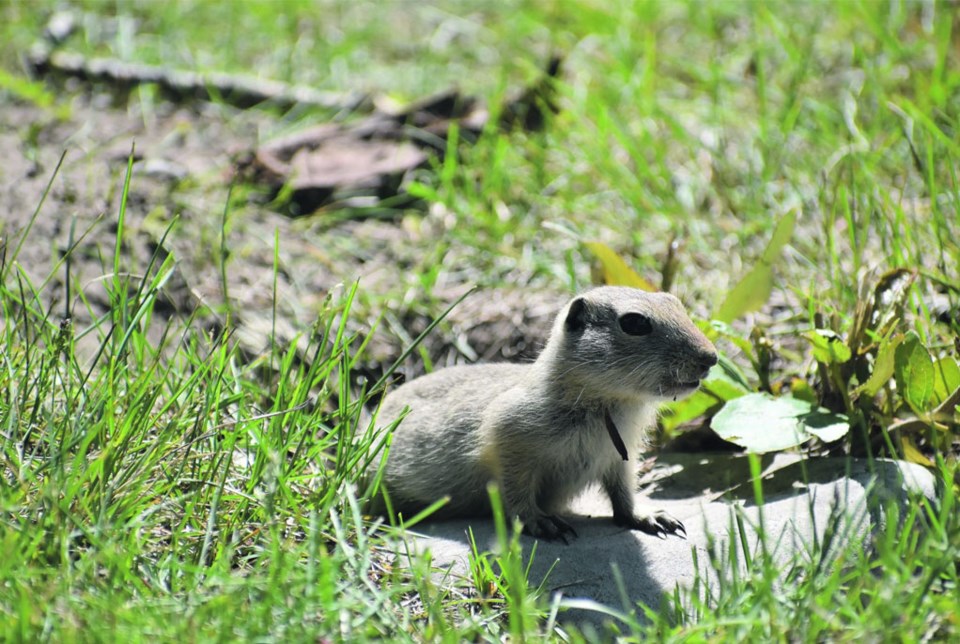REGINA — The cool, wet spring may have given producers a false sense of security when it came to Richardson’s ground squirrels.
They’ve since become the talk of the town, said James Tansey, Saskatchewan’s insect and vertebrate pest management specialist.
Some producers have had to reseed canola after significant damage, including Scott Anderson, who farms in the Briercrest, Sask., area. He said he had never lost crop to gophers like he has this year, and wondered if poisoned baits were working.
Tansey said the weather and delayed crop development were factors in the damage producers are now seeing.
“I think people probably looked at the populations early in the spring, and sometimes the populations can be deceivingly low,” he said.
If only the adult males and females are running around before farmers get busy in the spring, they might not get bait out in time.
That has to be done before crops start to green up.
“Typically you’re looking at April, maybe into the first week of May,” Tansey said.
“By the time you get to mid-May, you run the risk of the babies coming up already at that point, and once that happens your population quintuples.”
This year crop development was delayed, so the seedling canola was available by the time the hungry baby gophers came up.
“The food that’s available to the gophers remains relatively limited, and they tend to push into the field and really munch on a lot of individual seedlings and can cause some proportionately higher damage than they might if the crops had been growing vigorously,” he said.
Tansey said anti-coagulant baits such as Rozol and Ramik Green could still be used, but the effect will be muted.
Anti-coagulants affect the normal function of vitamin K in the gopher, and green growing plants are full of vitamin K.
“So they’re surrounded by the antidote for that particular mode of action,” he said.
Tansey said he did some tests a few weeks ago with bait stations and saw “moderate” knockdown of about 50 per cent. That was within about 15 metres of the bait station.
The good news, if it may be called that, is the adult males have already begun going back underground to overwinter, and the adult females should be doing so within a couple of weeks.
The bad news is the juveniles will stay active until October.
Tansey continues to evaluate the replacements for strychnine, which was phased out and eliminated last year. He said there is more to be learned.
Growers have wondered if a mid-season use of baits would mean the rodents would take it down into their cache for winter feeding, which could reduce spring populations.
“It seems logical, but is it true? We don’t know yet,” he said.
The Saskatchewan agriculture ministry and the Saskatchewan Association of Rural Municipalities do offer a rebate program for gopher control. These include rodenticides and other controls such as raptor platforms.
The program is a 50:50 cost-share rebate to a maximum of 50 per cent of registered control products and $125 for raptor platform materials.
Meanwhile, the same cool, wet spring hindered grasshopper development in many areas. Tansey said there are some pressures near Swift Current, the southwest and the Rosetown-Outlook areas, but not nearly what was expected.
The survey for cabbage seed pod weevil is underway, and he said the invasive pest, which in some years can cause severe damage in canola, is moving northward and eastward.
Tansey and staff were recently monitoring pea leaf weevil, and initial data suggests reduced risk this year except for a couple of hot spots in the southeast.
Flea beetles were not a major issue this year, but producers in the northwest were spraying.
“One thing that we’re seeing right now, and I think growers really need to keep an eye out, is diamondback moth,” he said. “They’re present in every field that I go to, and in some cases they’re approaching thresholds, so that’s something that growers and agronomists are going to really want to keep an eye out for.”
The first Bertha armyworm map was to be released this week.
Finally, Tansey said wheat midge really like the moist conditions, and growers should monitor for adults now.
“Unfortunately, we don’t have a phenology model this year,” he said, noting the Agriculture Canada researcher who used to produce it has retired and not been replaced yet.
Related
Sask. marshals service plans to emphasize rural presence
The head of the Saskatchewan Marshals Service says agricultural crime will be a focus for the new force.




